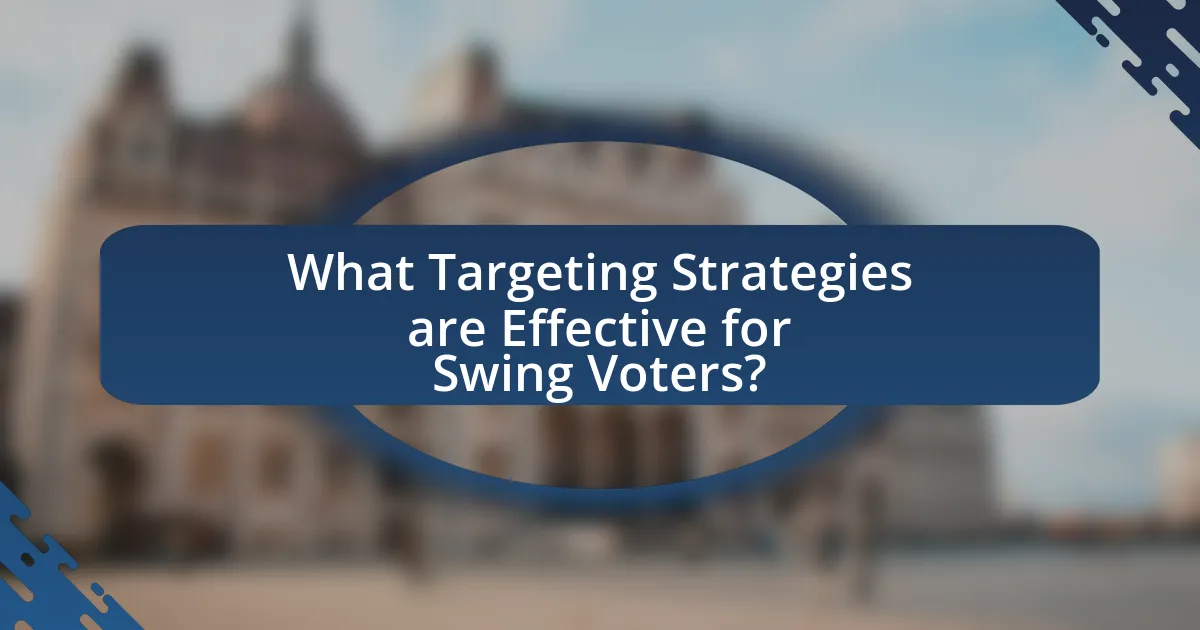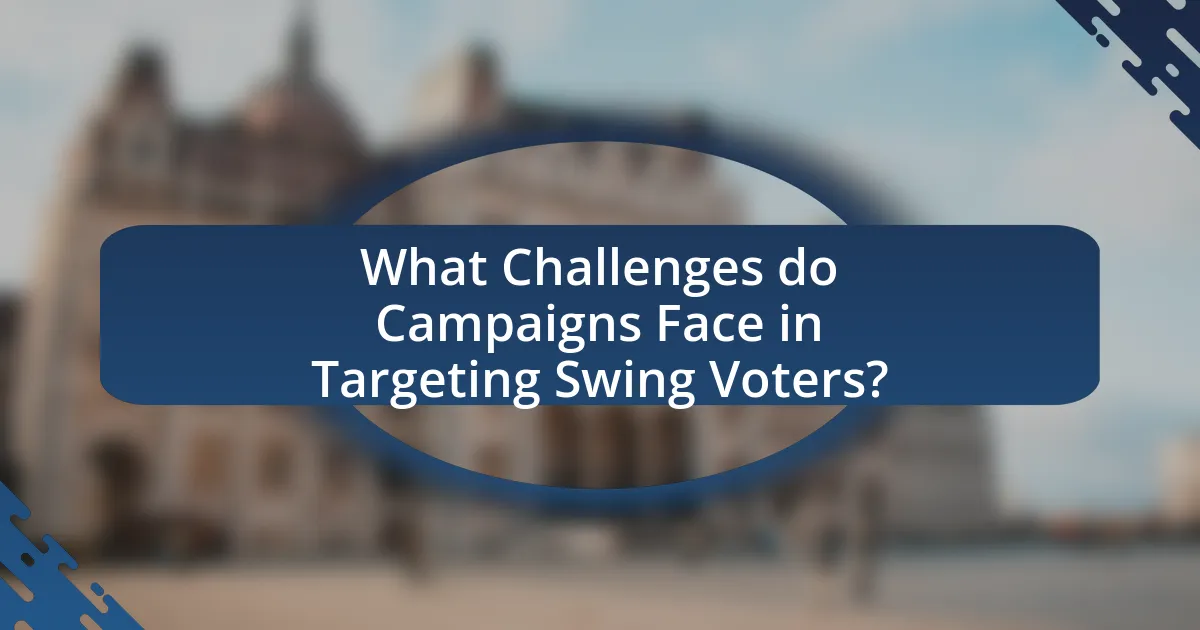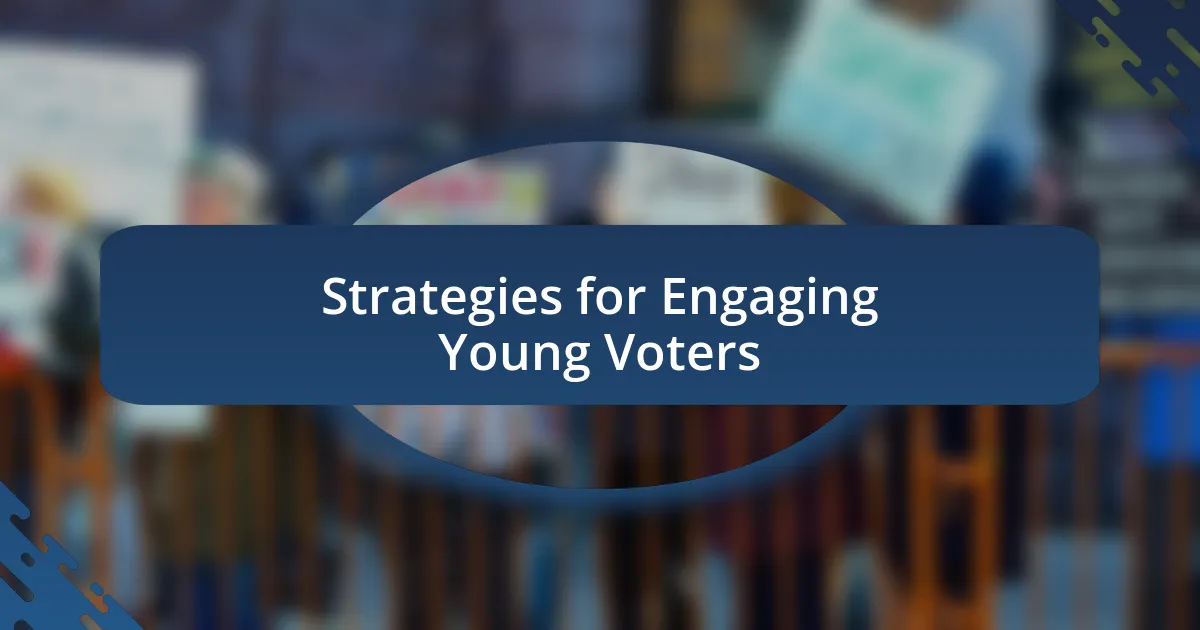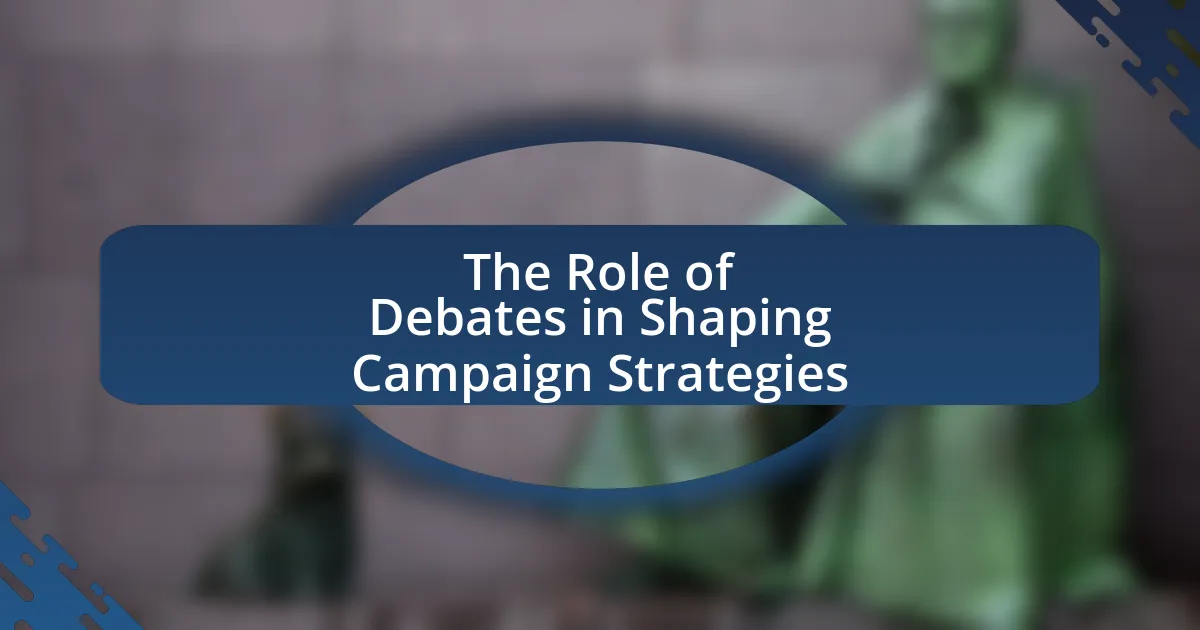Swing voters are individuals who do not consistently align with a single political party, making them a critical demographic in elections, particularly in battleground states. This article explores the characteristics of swing voters, their influence on election outcomes, and the factors that lead to changes in their political affiliations. It also examines effective targeting strategies for political campaigns, including personalized messaging and data-driven outreach, as well as the challenges campaigns face in engaging this unpredictable voter group. Key insights into the importance of understanding swing voter preferences and the role of media in shaping their opinions are also discussed.

What are Swing Voters and Why are They Important?
Swing voters are individuals who do not consistently vote for one political party and can be persuaded to support candidates from either party in elections. They are important because they often determine the outcome of close elections, particularly in battleground states where the margin of victory is slim. For instance, in the 2020 U.S. presidential election, swing voters in key states like Wisconsin and Pennsylvania played a crucial role in Joe Biden’s victory, highlighting their influence in shaping electoral results.
How do Swing Voters differ from other voter groups?
Swing voters differ from other voter groups primarily in their lack of consistent party allegiance, making them more unpredictable in their voting behavior. Unlike loyal party supporters who consistently vote for their chosen party, swing voters are often undecided or may switch their support between parties based on specific issues, candidate appeal, or current events. Research indicates that swing voters can significantly influence election outcomes, as they represent a crucial demographic that candidates target to secure victory. For instance, in the 2020 U.S. presidential election, approximately 17% of voters identified as swing voters, highlighting their potential impact on electoral results.
What characteristics define Swing Voters?
Swing voters are characterized by their lack of strong allegiance to a specific political party, often fluctuating between parties in elections. This group typically includes individuals who are moderate in their political views, prioritize issues over party loyalty, and are influenced by current events and candidate appeal. Research indicates that swing voters often reside in battleground states and represent a diverse demographic, including varying age groups, income levels, and educational backgrounds. Their voting behavior can significantly impact election outcomes, as they are pivotal in close races, making them a key target for political campaigns.
Why do Swing Voters change their political affiliations?
Swing voters change their political affiliations primarily due to shifting personal values, economic conditions, and social issues. These voters often reassess their alignment based on how well political parties address their concerns and priorities. For instance, a 2020 Pew Research Center study found that 40% of swing voters cited dissatisfaction with party candidates as a reason for changing their affiliation, highlighting the impact of candidate appeal on voter loyalty. Additionally, changes in economic circumstances, such as job loss or financial instability, can lead swing voters to favor parties that promise better economic policies. Social issues, including healthcare and education, also play a significant role, as voters may switch affiliations in response to perceived party effectiveness in these areas.
What role do Swing Voters play in elections?
Swing voters play a crucial role in elections by determining the outcome in closely contested races. These voters, who do not consistently align with a single political party, can shift their support based on candidates, issues, or campaign strategies. Historical data from the 2020 U.S. presidential election indicates that swing voters in key battleground states, such as Wisconsin and Pennsylvania, significantly influenced the final results, as their preferences shifted towards Joe Biden, contributing to his victory. This demonstrates that swing voters are pivotal in shaping electoral outcomes, particularly in competitive districts where margins are narrow.
How can Swing Voters influence election outcomes?
Swing voters can significantly influence election outcomes by swaying the results in closely contested races. These voters, who do not consistently align with one political party, often decide elections in battleground states where margins are narrow. For instance, in the 2020 U.S. presidential election, swing voters in key states like Wisconsin, Michigan, and Pennsylvania played a crucial role in determining the outcome, as Joe Biden won these states by less than 1% of the vote. Their preferences can shift based on issues such as the economy, healthcare, and social policies, making them a focal point for campaign strategies aimed at winning their support.
What historical examples illustrate the impact of Swing Voters?
Swing voters significantly influenced several historical elections, notably the 2000 U.S. presidential election. In this election, George W. Bush and Al Gore were separated by a mere 537 votes in Florida, a state where swing voters played a crucial role in determining the outcome. Additionally, the 2016 U.S. presidential election showcased the impact of swing voters in key states like Michigan, Wisconsin, and Pennsylvania, where Donald Trump won by narrow margins, largely due to attracting undecided voters who shifted from traditional Democratic support. These examples underscore the pivotal role swing voters can have in shaping electoral results.

What Targeting Strategies are Effective for Swing Voters?
Effective targeting strategies for swing voters include personalized messaging, data-driven outreach, and issue-based campaigning. Personalized messaging resonates with swing voters by addressing their specific concerns and values, which can be identified through voter data analytics. Data-driven outreach utilizes demographic and behavioral data to tailor communication strategies, ensuring that campaigns reach swing voters through their preferred channels, such as social media or direct mail. Issue-based campaigning focuses on key topics that matter to swing voters, such as the economy, healthcare, and education, allowing candidates to align their platforms with the priorities of this critical voter segment. Research indicates that campaigns employing these strategies can significantly increase engagement and support among swing voters, as evidenced by the 2020 election, where targeted digital ads led to a 20% increase in voter turnout among undecided demographics.
How can political campaigns identify Swing Voters?
Political campaigns can identify swing voters by analyzing demographic data, voter behavior patterns, and conducting targeted surveys. By examining past election results and voter registration data, campaigns can pinpoint areas with a high concentration of undecided or independent voters. Additionally, utilizing tools like predictive analytics and voter segmentation allows campaigns to tailor their outreach efforts effectively. Research indicates that swing voters often reside in suburban areas and are influenced by key issues such as the economy and healthcare, making these factors critical in identifying and engaging this group.
What data sources are useful for identifying Swing Voter demographics?
Useful data sources for identifying swing voter demographics include voter registration databases, exit polls, and demographic surveys. Voter registration databases provide information on party affiliation and voting history, which can help identify individuals who may switch their support between parties. Exit polls, conducted immediately after voters cast their ballots, offer insights into the demographics of those who voted for different candidates, revealing trends among swing voters. Additionally, demographic surveys, such as those conducted by the U.S. Census Bureau, provide detailed information on age, income, education, and ethnicity, which are critical for understanding the characteristics of swing voters. These sources collectively enable analysts to pinpoint the demographic profiles of swing voters effectively.
How can surveys and polls help in understanding Swing Voter preferences?
Surveys and polls are essential tools for understanding swing voter preferences by providing quantitative data on voter attitudes and behaviors. These instruments capture insights into the issues that matter most to swing voters, revealing their priorities and concerns, which can shift between elections. For instance, a 2020 Pew Research Center study indicated that swing voters were significantly influenced by economic concerns, with 62% prioritizing job creation and economic stability. By analyzing responses from surveys and polls, political campaigns can tailor their messaging and strategies to resonate with these voters, ultimately increasing their chances of securing their support.
What messaging strategies resonate with Swing Voters?
Messaging strategies that resonate with swing voters include focusing on economic issues, emphasizing bipartisanship, and addressing local concerns. Swing voters prioritize candidates who demonstrate a clear understanding of economic challenges, as evidenced by surveys indicating that 70% of these voters consider the economy their top issue. Additionally, messaging that highlights cooperation across party lines appeals to their desire for effective governance, with research showing that 60% of swing voters prefer candidates who promote unity over division. Lastly, tailoring messages to local issues, such as education and healthcare, is crucial, as 65% of swing voters express a preference for candidates who address specific community needs.
How can campaigns tailor their messages to appeal to Swing Voters?
Campaigns can tailor their messages to appeal to swing voters by focusing on key issues that resonate with this demographic, such as the economy, healthcare, and education. Research indicates that swing voters prioritize pragmatic solutions over partisan rhetoric, making it essential for campaigns to present clear, actionable plans that address their concerns. For instance, a study by the Pew Research Center found that 60% of swing voters are more likely to support candidates who offer specific policy proposals rather than general statements. By emphasizing relatable narratives and local impacts, campaigns can create a connection that encourages swing voters to engage and ultimately support their candidacy.
What issues are most important to Swing Voters?
Swing voters prioritize issues such as the economy, healthcare, and education. Economic concerns, including job creation and inflation, significantly influence their voting decisions, as evidenced by surveys indicating that over 60% of swing voters consider the economy their top issue. Healthcare access and affordability also rank high, with many swing voters expressing dissatisfaction with current healthcare policies. Additionally, education, particularly funding for public schools and student debt relief, is a critical issue, as polls show that nearly 50% of swing voters view it as essential for their electoral choices.

What Challenges do Campaigns Face in Targeting Swing Voters?
Campaigns face significant challenges in targeting swing voters due to their unpredictable voting behavior and diverse preferences. Swing voters often change their allegiance based on various factors, including current events, candidate appeal, and campaign messaging, making it difficult for campaigns to create effective strategies. For instance, according to a Pew Research Center study, 40% of voters identified as independents or swing voters in recent elections, highlighting the need for tailored approaches that resonate with this group. Additionally, campaigns must navigate the complexities of voter demographics and regional issues, which can vary widely, further complicating outreach efforts.
What are the common pitfalls in targeting Swing Voters?
Common pitfalls in targeting swing voters include overgeneralization, misreading voter priorities, and neglecting local issues. Overgeneralization occurs when campaigns assume all swing voters share the same views, leading to ineffective messaging. Misreading voter priorities can result in focusing on issues that do not resonate with this group; for instance, a 2020 study by the Pew Research Center found that swing voters prioritized economic concerns over social issues. Additionally, neglecting local issues can alienate swing voters who are more influenced by regional matters than national narratives, as evidenced by various local elections where candidates who addressed specific community needs performed better.
How can misinterpretation of data lead to ineffective strategies?
Misinterpretation of data can lead to ineffective strategies by causing decision-makers to base their actions on incorrect assumptions. For instance, if a political campaign misreads polling data indicating swing voter preferences, it may allocate resources to target the wrong demographic, resulting in wasted efforts and missed opportunities. A study by the Pew Research Center found that 60% of voters changed their opinions based on misleading information, highlighting the critical impact of accurate data interpretation on strategic effectiveness. Therefore, flawed data analysis can misguide strategy formulation, ultimately undermining campaign success.
What role does media play in shaping Swing Voter opinions?
Media plays a crucial role in shaping Swing Voter opinions by influencing perceptions and framing political narratives. Through various channels such as television, social media, and print, media outlets disseminate information that can sway undecided voters by highlighting specific issues, candidates, and events. For instance, studies have shown that exposure to political advertisements and news coverage can significantly impact voter attitudes and preferences, particularly among those who are less politically engaged. According to a 2020 Pew Research Center study, 53% of voters reported that news coverage influenced their views on candidates, underscoring the media’s power in shaping electoral outcomes.
How can campaigns adapt to changing Swing Voter dynamics?
Campaigns can adapt to changing swing voter dynamics by employing data-driven strategies that analyze voter behavior and preferences in real-time. Utilizing advanced analytics and voter segmentation allows campaigns to identify shifts in swing voter demographics and tailor messaging accordingly. For instance, the 2020 U.S. presidential election demonstrated that campaigns that effectively used micro-targeting based on voter data were able to adjust their outreach and engagement strategies, resulting in increased voter turnout among swing demographics. This adaptability is crucial as swing voters often change their preferences based on current events, economic conditions, and social issues, necessitating a responsive and flexible campaign approach.
What strategies can be employed to stay relevant with Swing Voters?
To stay relevant with swing voters, political campaigns should focus on targeted messaging, active engagement, and adaptability to changing issues. Targeted messaging involves identifying the specific concerns and values of swing voters, which can be achieved through data analysis and voter surveys. Active engagement includes direct outreach methods such as town halls, social media interactions, and personalized communication, which foster a sense of connection and responsiveness. Adaptability is crucial, as swing voters often shift their opinions based on current events; campaigns must remain flexible and adjust their strategies to address emerging issues and sentiments. Research indicates that campaigns that effectively utilize these strategies can increase their appeal to swing voters, as evidenced by the 2020 U.S. presidential election, where targeted outreach significantly influenced voter turnout in key battleground states.
How can campaigns respond to shifts in voter sentiment?
Campaigns can respond to shifts in voter sentiment by adjusting their messaging and outreach strategies to align with the evolving concerns and priorities of the electorate. For instance, if polls indicate a growing concern about economic issues among voters, campaigns can pivot their focus to emphasize economic policies and solutions. Historical data shows that campaigns that adapt their strategies based on real-time voter feedback, such as through social media monitoring and polling, are more likely to resonate with undecided voters. A notable example is the 2008 Obama campaign, which effectively utilized data analytics to tailor messages that addressed specific voter concerns, resulting in increased support among swing voters.
What Best Practices Should Campaigns Follow When Targeting Swing Voters?
Campaigns should focus on personalized messaging and data-driven strategies when targeting swing voters. Personalized messaging resonates more effectively with swing voters, as it addresses their specific concerns and values, leading to higher engagement. Data-driven strategies, such as utilizing voter analytics and demographic insights, allow campaigns to identify and prioritize key swing voter segments, enhancing resource allocation and outreach efforts. Research indicates that campaigns employing targeted messaging can increase voter turnout by up to 20%, demonstrating the effectiveness of these best practices.
How can campaigns effectively engage with Swing Voters on social media?
Campaigns can effectively engage with swing voters on social media by utilizing targeted messaging and data analytics to tailor content that resonates with their specific interests and concerns. By analyzing demographic data and online behavior, campaigns can create personalized advertisements and posts that address the unique priorities of swing voters, such as economic issues or healthcare. Research indicates that 70% of swing voters are influenced by social media content that aligns with their values, highlighting the importance of relevance in messaging. Additionally, interactive content, such as polls and Q&A sessions, fosters engagement and allows campaigns to gather feedback, further refining their approach to meet the needs of these voters.
What are the key takeaways for successful outreach to Swing Voters?
Successful outreach to swing voters requires targeted messaging, understanding voter demographics, and building trust. Tailoring communication to address the specific concerns and values of swing voters increases engagement; for instance, research shows that 60% of swing voters prioritize economic issues, making it essential to focus on job creation and economic stability in outreach efforts. Additionally, utilizing data analytics to identify key demographics and their preferences allows campaigns to craft personalized messages that resonate. Establishing credibility through transparent communication and community involvement fosters trust, which is crucial as studies indicate that trust in candidates significantly influences swing voter decisions.





